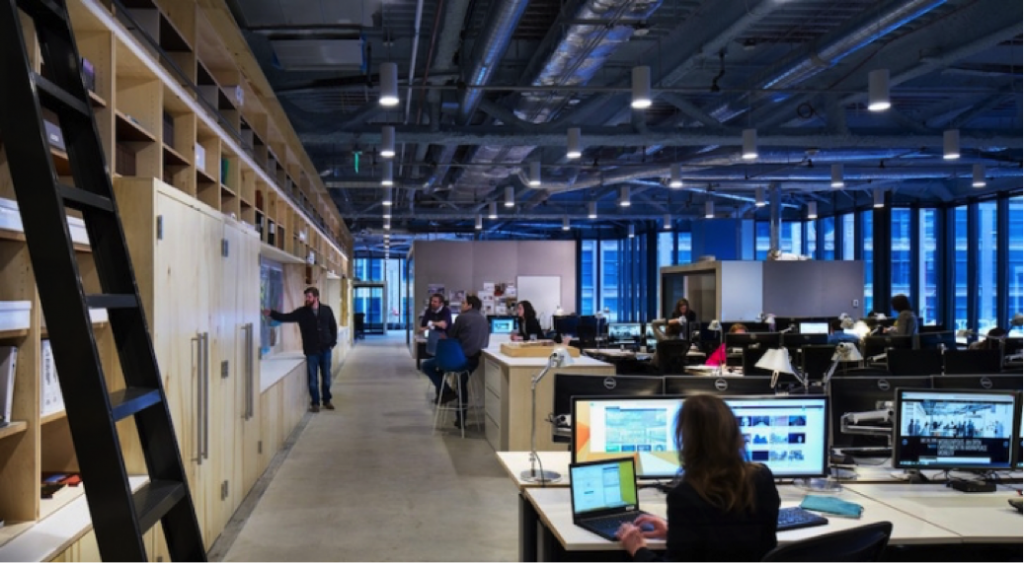An authentic culture cannot be forced but can be encouraged and supported.
By Hakee Chang, Denise Darrin and Lisa Weeks, Building Design & Construction, 2/2/2017
View the original article here.
 The workplace has evolved exponentially over the past decade, from large, uniform workstations and offices to efficient open plans and auxiliary areas. Technology has advanced from desktop computers and landlines, to laptops, and mobile apps. Innovation in technology has driven an increase in employees’ productivity and efficiency, and innovation in design has strategically followed.
The workplace has evolved exponentially over the past decade, from large, uniform workstations and offices to efficient open plans and auxiliary areas. Technology has advanced from desktop computers and landlines, to laptops, and mobile apps. Innovation in technology has driven an increase in employees’ productivity and efficiency, and innovation in design has strategically followed.
However, effective and engaging workplace design doesn’t stop with a response to technological and real estate needs. It must go further, supporting the creation and integration of a company’s culture, brand identity, and overall community.
CURATED CULTURE
The most integrated cultures are co-created by leaders and teams. They are shared, organic, and capable of evolving. An authentic culture cannot be forced, but can be encouraged and supported. Without direct participation and buy-in from those involved, a company’s culture can end up a “mission statement on business card” or a “tagline on a wall” – noticed upon move-in, but quickly forgotten thereafter.
We have been fortunate to see these principles in action with a number of our key clients. In particular, technology companies are dealing with cultural change on almost a daily basis as a result of rapid growth. For example, one financial technology client has an ever-adapting nature and willingness to learn. Their leadership embodies an approach that has allowed exceptionally talented people of various backgrounds to come together with a unified and understood purpose.
The ethos of any company is the driving force. People connect over shared stories and experiences. Our job as workplace designers is to clearly understand the experiences of each and every client. What are their company’s particular drivers and values? How we can create a space that reflects and enhances those values and support the natural curation of their culture?
BUILDING BRAND AWARENESS
Understanding a client’s brand in the context of external perception and internal practices are two crucial elements to designing a meaningful workplace. Through visioning and programming interviews, we find that office staff often seeks their work environment to “walk the talk.” It has to be authentic and reflect the reasons why they joined the company, and offer opportunities to highlight how their contributions matter.
As a first step, we typically will create overlapping layers of an “experience map” to begin building a workplace design that contributes to the client’s ethos. We map out various use scenarios through points of view, such as anticipating the tour our client may give to a candidate or business partners, an all-hands meeting, or an event for external community engagement. These maps overlap with curated moments where people can connect to individual stories or testimonials that are both inspirational and aspirational.
We recently worked with a technology company whose focus is on physical activity and health, and we incorporated design elements to encourage movement. For example, we designed meeting spaces with treadmills, social and collaboration spaces along popular walking routes, and adaptable spaces with natural light, comfortable temperatures, and views. Since the company offices are spread between buildings within a dense urban location, we leveraged the city as a vital active conduit to tie both the company’s brand and connect staff with their customer base. Allowing workflow through the neighborhood created a first-hand brand awareness that extends beyond the interior office environment.
COMMUNITY GUIDELINES
Technology has allowed the traditional office to transform into a dynamic working environment. The workplace is no longer built on “my” office or “my” desk, but has developed into “our” space: a place for community.
Technology has provided flexibility, choice, and options to employees – giving everyone the ability to decide where, how, and when they work. Yet, the reduction of individual workspace has created a need for smaller neighborhoods within the larger community. To help alleviate the possibility of feeling “crowded” it is essential to effectively distribute varied opportunities for different work styles, while providing adequate support and shared spaces.
All of these factors have prescribed that companies establish community guidelines, the rules of engagement for the workplace. These guidelines address issues from etiquette to functionality.
Our Minneapolis office recently relocated and moved to an activity-based “free address” work environment with no assigned seats to untether talent from desks and empower employees with choice. Etiquette guidelines were created to assist in this new environment, including:
- Individuals are expected to clear their workspace of all materials if out of the office for more than four hours, and when they leave at the end of the day, so the location can host another user.
- Meeting rooms have different behaviors and etiquette associated with them. For instance, huddle rooms are non-reservable and dedicated to more informal, spontaneous meetings or calls.
- Project storage, personal storage, and office supplies have centralized home bases outside of the immediate workstations to prevent duplication and waste.
As an overall goal, the new workspace recognizes the value of a variety of workstyles: from large group meetings to spontaneous interactions to individual heads-down work. The studio supports this spectrum of work with project rooms, huddle rooms, pin-up spaces, and focus rooms.
Community guidelines present the parameters for employees to respect each other and their work places and to follow the “Platinum Rule”: treat others the way they want to be treated.
